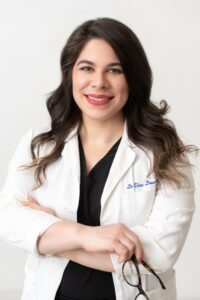August 1, 2023
By Tina Douroudian, OD
These conversations can be daunting initially, but a strategic, efficient, and personalized approach can make those talks easier and more effective.
 After graduating from The State University of New York, College of Optometry in 2013, I worked in a variety of different settings: a corporate office, a private practice, a medical center at NYU, a pediatric mobile clinic, and as the head of a hospital’s pediatric department.
After graduating from The State University of New York, College of Optometry in 2013, I worked in a variety of different settings: a corporate office, a private practice, a medical center at NYU, a pediatric mobile clinic, and as the head of a hospital’s pediatric department.
I always knew I wanted to focus on pediatrics, specifically myopia management. Since moving to Northern Virginia in 2019, I’ve been able to do just that, first by creating myopia management protocols for a large organization with hundreds of locations, and now by working at Arlington Loudoun Pediatric Ophthalmology, a private pediatric ophthalmology practice, located in Sterling, Virginia.
Over time, I’ve expanded my services to include low-dose atropine, orthokeratology, soft multifocal contacts, and custom-designed lenses. I have dealt with hundreds of advanced cases requiring unique solutions. Each of those cases began with a conversation. I’ve developed a four-part technique that allows me to efficiently get all critical information across without overwhelming parents and patients.
Step 1: Be Prepared
The most important step is being prepared to have an in-depth conversation about the risks, benefits, and alternatives to myopia management. I anticipate parents’ and patients’ questions and concerns, as well as the information they need, and I make sure that all of this is available in a written format. Most of the time, both parents don’t come to an exam. When two decision-makers are involved, it’s much easier to ensure they both have the correct information by giving them written details they can take home. I include the fees for various treatment plans, infographics about myopia, screen time advice, and research papers showing the importance of controlling disease progression. Some of my favorite resources are Mark Bullimore’s “Why Each Diopter Matters,” the LAMP and MiSight studies, and schematics on the magic of how OrthoK works.
Being prepared also means deciding, as a clinician, whether I can have an effective conversation at the time of the exam or if bringing the parent and patient back to do it later is a better choice. If squeezing in a conversation means falling significantly behind schedule, I find that I’m too rushed and not in the right headspace to answer all the questions parents and patients often have. Separate consultations may work best for your schedule.
I’ve also found it’s very effective to prepare scripts ahead of time. Here’s an example:
“Myopia, or nearsightedness, is really two things: 1) it’s the blur we get because 2) the eye is growing too long. When the eye grows too long too quickly, the patient is at a higher risk of issues that affect the health of the eye — things like glaucoma, retinal detachments, or a form of macular degeneration. These things don’t typically happen to children, but myopia rapidly progresses during childhood, and now is our opportunity to change the trajectory of Alice’s eye health.”
Step 2: Create Curiosity
Creating curiosity around myopia management can be as simple as asking a question. “Did you know that there are several really effective options to help Johnny’s eyes not worsen so quickly?” In my office, we check the axial length of all patients. While the family is waiting for me, the parent is reading over their child’s results, along with an explanation of why axial length is extremely important and how it is connected to potential vision loss as an adult. This alone is often enough to create curiosity about treatment options.
Step 3: Read the Room
Like anything else, conversations about myopia management vary from patient to patient and family to family. Some parents are initially skeptical: “Why haven’t I heard of this before?” I usually respond with, “While myopia itself is not a new problem, we are learning more and more every day not only how problematic it is but also what we can do about it.”
Sometimes, parents still need a better understanding of what myopia is, and in those cases, we can use plus lenses to demonstrate the level of myopia. I try to focus on reducing the risk of disease and the permanent effect of axial elongation rather than the prescription itself because the “solution” of refractive surgery tends to make parents incorrectly think action now is unnecessary.
When having these conversations, I often try to include the patient by asking what questions they have or whether they might be leaning toward one treatment plan or another. Unless there are very compelling clinical reasons that only one course of action will work, I do not subscribe to the notion that I must dictate which treatment a patient gets. I explain the pros and cons of each treatment and give a thorough risk/benefit analysis. This approach allows us to make the decision together, and I believe compliance is better when patients feel they are part of the decision-making process.
Part of reading the room is periodically checking in with parents and patients to ask if they need any clarification or have any questions. Sometimes, I’ll get pushback from a child who doesn’t want treatment. In these cases, I explain that the treatments I am describing may not sound like “fun,” but they will benefit the health of their eyes and vision in the long run.
Step 4: Be Available for Questions
Most of the families I speak with are getting new information — and a lot of it — all at once. I encourage them to digest that information at home, and my team or I will follow up with them in a couple of weeks. I also give them my email address so they can reach out with any questions they might think of later.
These conversations can be daunting initially, but a strategic, efficient, and personalized approach can make those talks easier and more effective.
 |
Dr. Tina Douroudian graduated from the State University of New York College of Optometry. She is a member of the American Academy of Orthokeratology and Myopia Control and a member at-large of the Board of Trustees for the Northern Virginia Optometric Society. She was the head of a pediatric department of a hospital-based ophthalmology clinic in Brooklyn, NY, where she worked with ophthalmologists of different subspecialties, and she was the clinical educator and supervisor for SUNY Optometry 4th year student interns. She worked with a pediatric mobile clinic in New York City where she provided no-cost eye exams and glasses for tens of thousands of children throughout NYC’s five boroughs. She lives in Sterling, Virginia, with her husband and children. You can follow her on Instagram at @idoctortina. |













